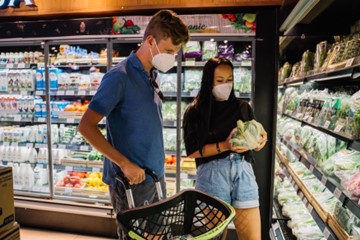It gets hard to stay on budget while grocery shopping, especially when deals are shoved in your face through every aisle you walk in. When you see the big words spelling “Sale” on a product you do not even need; the temptation becomes hard to resist.
Do not fret; the temptations can be controlled, and you will be able to follow your grocery list. Here are some tips or advice for you to be mindful of on your next trip to the grocery store.
Make a Shopping List
One may think making a shopping list is a waste of time, but it helps you a lot. A grocery list should be filled with items that you are sure you need. Going to the store without a list to refer to can be tricky as it is that easy to grab something that you do not need randomly.
By writing down and sticking to the grocery list, you will be able to save money and only reach for the items that you need. It is also important to write down the items you can use more than once a week. For example, having a type of vegetable that you can make into more than one dish.
Reverse Shopping List
Similar to the shopping list, the reverse shopping list is also helpful to ensure you do not spend too much. The list consists of things you may have in your pantry. Then you check your pantry before leaving, checking off the items you already have. So, the list now only consists of items you do not have.
There are a lot of instances where we end up buying something we already have back home. This happens because we usually do not bother to check our pantry or kitchen before leaving. With the reverse shopping list that you can refer to, you will not be buying doubles.
Go by Yourself
An easy tip to follow would be to go to the grocery store alone. This will help you not to have too many in your shopping cart. This is because, when you shop with your significant other or your kids, you are more likely to be influenced into buying stuff that you do not need.
Furthermore, going in a group will also make you look at your shopping list less, making you buy unnecessary items. Moreover, you will not be the only one reaching out to grab items, making it hard not to overlook unneeded items.
Online Grocery Shopping
If you are not too keen on leaving the house or going on your own, you could always try grocery online as easy as accessing from your HP laptop. Grocery shopping has become much easier these days and has become available online.
Online grocery shopping is convenient as you can easily browse through the catalog whenever you want to. Moreover, you will not have to wait for the stores to open or wait for the staff to restock the aisles. Not only that but you will also save time and energy by not leaving your house.
Adding to this, by doing your groceries online, you can even compare prices without the hassle of the physical store brings. All you need to do is download the apps from Android phone and you would be able to do everything you usually do in a physical store but easier.
Get Discounted Items
Grocery stores usually have deals, sales, and discounted items to help you save money. From products like milk to candies and drinks, there is surely a discount for the item you are looking for.
You should consider purchasing products on sale, especially if the price is normally high. Sale items are frequently clearly displayed throughout the store, such as at the entrance and end of aisles. In addition, sale items are marked with banners and signs to make them easy to find.
Prepared Foods Aisle
Next, you should try not to go to the prepared food aisle where single servings of food are made ready to be bought and eaten. This is because the cost of prepared foods is generally higher than the cost of you making the same food on your own.
The prepared foods typically include dressings, toppings, and even cutlery in the food container. So, you are not only paying for the food but also other inclusions. So, to save money, you should opt for making the food yourself instead of buying a ready-to-eat version of it.
Bring Your Own Grocery Bag
This may be a trivial thing, but it could also be a game-changer. Some stores may charge you for grocery bags, adding to your existing bill and making you pay more. If you decide not to pay extra for the grocery bag, you will have to use your hands to bring the items back home.
To avoid this, you could simply just bring your grocery bag. Not only is it sturdier than the usual plastic bags the store gives you, but it is also more eco-friendly. With this, you are not only saving money but the earth as well.










